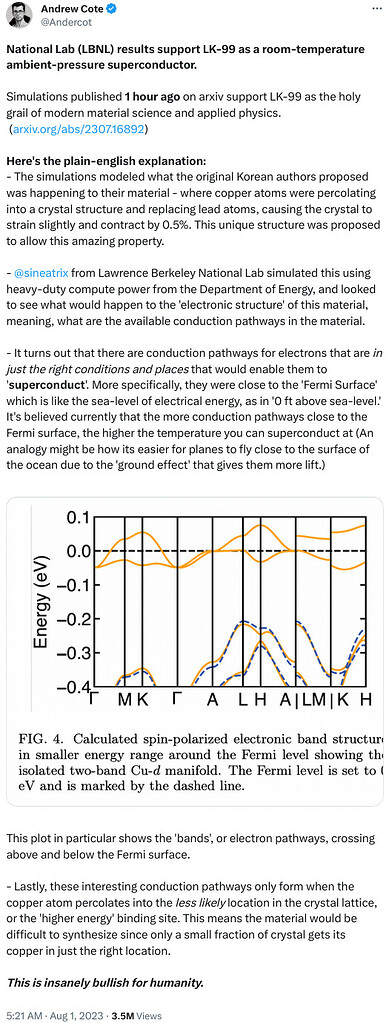Next, on 2023-08-01, we have a second theoretical paper up on arXiv, “Origin of correlated isolated flat bands in copper-substituted lead phosphate apatite” (full text at the link), by Sinéad M. Griffin of the Materials Sciences Division, Lawrence Berkeley National Laboratory, Berkeley, California, reporting density functional theory calculations of the LK-99 material reported to exhibit high-temperature superconductivity. Here is the abstract.
A recent report of room temperature superconductivity at ambient pressure in Cu-substituted apatite (`LK99’) has invigorated interest in the understanding of what materials and mechanisms can allow for high-temperature superconductivity. Here I perform density functional theory calculations on Cu-substituted lead phosphate apatite, identifying correlated isolated flat bands at the Fermi level, a common signature of high transition temperatures in already established families of superconductors. I elucidate the origins of these isolated bands as arising from a structural distortion induced by the Cu ions and a chiral charge density wave from the Pb lone pairs. These results suggest that a minimal two-band model can encompass much of the low-energy physics in this system. Finally, I discuss the implications of my results on possible superconductivity in Cu-doped apatite.
Here is Andrew Cote’s take on the paper, posted on Twitter within an hour of its publication.
This is the final paragraph of the “Discussion” section at the end of the original paper.
Finally, the calculations presented here suggest that Cu substitution on the appropriate (Pb(1)) site displays many key characteristics for high-{\rm T}_C superconductivity, namely a particularly flat isolated d-manifold, and the potential presence of fluctuating magnetism, charge and phonons. However, substitution on the other Pb(2) does not appear to have such sought-after properties, despite being the lower-energy substitution site. This result hints to the synthesis challenge in obtaining Cu substituted on the appropriate site for obtaining a bulk superconducting sample. Nevertheless, I expect the identification of this new material class to spur on further investigations of doped apatite minerals given these tantalizing theoretical signatures and experimental reports of possible high-{\rm T}_C superconductivity.
